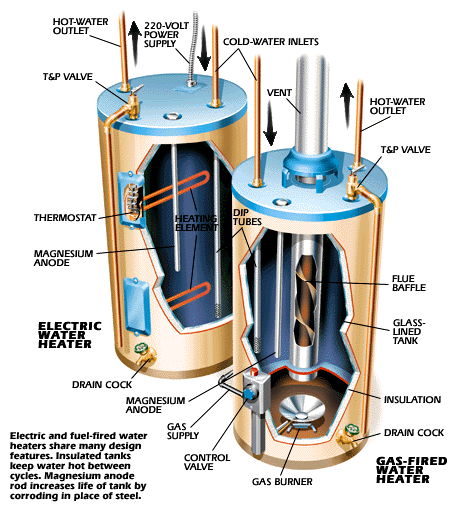That a BTU or British Thermal Unit = The amount of heat energy used to increse 1 pound of water 1 degree.
That natural gas is sold in therms and a therm = 100,000 btu's.
That 1 cubic foot of natural gas = 1,000 btu's.
That 1 cubic foot of propane gas = 2,100 - 2,500 btu's.
That 1 kw or kilo watt = 3,413 btu's.
That the plumbing term for a toilet is water closet.
That a tank type water heater only provides 70% of it's stored capacity for the set tempeture. A 50 gallon water heater will produce 35 gallons of water per hour at the
temperture setting on the heater.
That water weighs 8.33 pounds per gallon.
That a 12" inch column of water = .434 PSI
That the average amount of water used per person per day at home is
65 gallons.
Tankless Heaters
If your home doesn't have a hot-water tank, you probably have a hot-water or steam home-heating system that also heats water for your taps. To accomplish the job, your boiler has a tankless water
heater. In this system, a coil of pipe is connected at one end to the cold water supply, and at the other to your hot-water delivery piping. As the boiler heats the water that warms your home, that
water heats the coil, creating hot water at your taps.
Because tankless heaters only heat water as it's used, there's no cost for maintaining heat in a large volume of water during periods of low usage. However, they do have a few drawbacks. First,
the hot water generated is far hotter than necessary, so a cold-water mixing valve should be installed to reduce the chance of scalding. Second, the boiler must fire to generate hot water—which is
efficient during the winter months, but decidedly more wasteful when the weather is warm. Like tank-type heaters, tankless heaters are designed to achieve a specific heating rate. Once the rate is
exceeded by demand, the temperature of the water drops. In some cases, storage tanks are connected to the heating coil to increase hot-water availability.
In addition to boiler-mounted tankless heaters, stand-alone units are available. Gas-fired instantaneous water heaters utilize a coil and heat exchanger to heat water as it's required. Like
boiler-mounted units, instantaneous water heaters don't use energy to maintain the heat in a volume of water, but only fire as hot water is required. A downside is that stand-alone units typically
have a lower flow rate than boiler-mounted systems and may fall short during periods of high demand.


